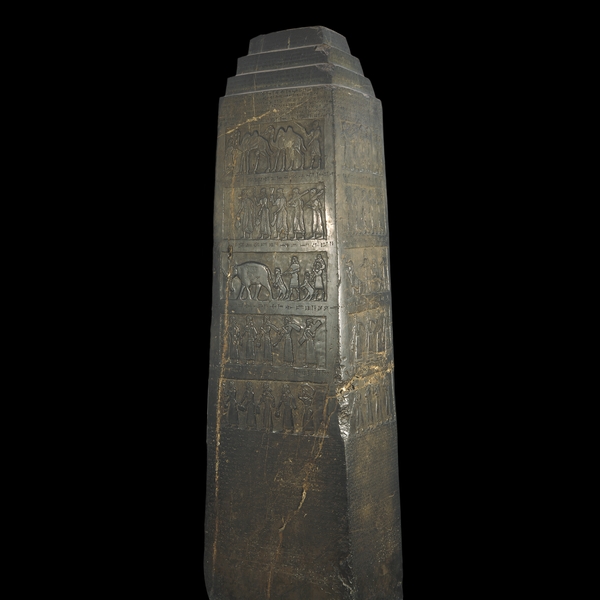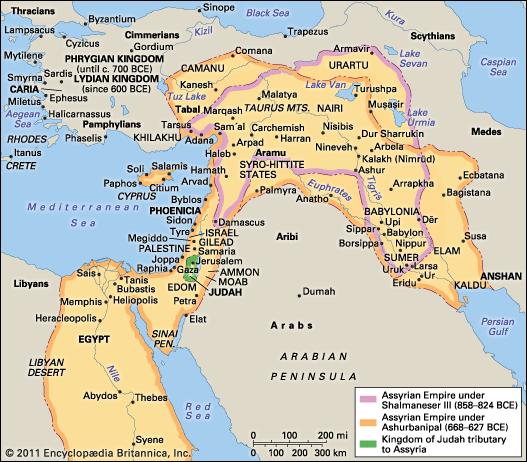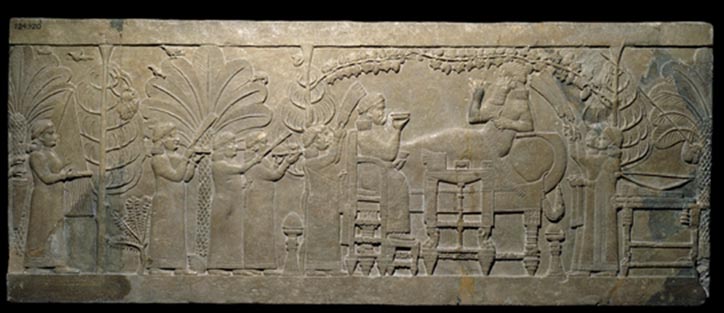Ashuranasirpal II (Ashur-nasir-pal) (884-859 BC) made the foundations of military power in Assyria. Historians so far know 14 major campaigns in 24 years of his rule. He led three campaigns to the east, where he brought the population as slaves in city Kalhu (today Nimrud). He led also more campaigns to the north and northeast, where he conquered the country Urartu and Nairi. In those places, he made extensive administrative measures, which ensured him steady income throughout the reign. Throughout the entire period of his government, he was waging the war in the west, where the Assyrians came all the way to the Mediterranean Sea.
The expansion of the Assyrian influence in the east, encouraged Bit – Adini, Aramaic country in the Middle Euphrates to organize anti – Assyrian coalition. Ashurnasirpal II very cruelly quells this rebellion. After that, the Neo Hittite ruler of Carchemish and rulers of Phoenician cities agreed to pay tax to him.
His conquest opened the way for a great expansion in VIII century. Huge war prey allowed him to raise new capital Kalhu, north of Ashur. Prisoners, who were brought to Assyria, mostly populated the town. In the new capital, a ruler built his palace and filled it with numerous sculptures, paintings, and inscriptions, reliefs on the walls, which depicted mythological scenes as well as his military successes. However, his conquests brought only nominal authority over Syria.



Shalmaneser III. (858-824) – ruled in the second half of the V century BC. In the course of his 35-year reign he has made 32 conquests. He has led battles on all borders of his country. He tried to established authority over the territory of Syria. However, Syrian principalities were prepared this time for the Assyrian troops. Bit-Adini city, with the help of other north – Syrian principality resisted for three years. In the end, however, the territory of this kingdom was turned into Assyrian province.
Meanwhile principalities of southern Syria and Palestine have formed new coalition against Shalmaneser III. In 853 BC at the Battle of Qarqar, this coalition, which was led by the king of Damascus, had approximately 70.000 people. Assyrian sources talked about Shalmaneser III victory, but they do not mention any conquered city. The coalition fell apart when in Damascus came to turning point in 845 BCE. Tyre, Sidon, and Israel from 841 BCE paid tax to Assyria, and these cities left Damascus to oppose to Shalmaneser alone. At the end of Shalmaneser III reign, the power over the Levant began to wane. His eldest son rebelled against his father. The riots raged through Ashur, Nineveh and other cities. For his successor, Shalmaneser made his younger son Shamshi – Adad V (823-811). Shamshi – Adad two years after his father’s death suppressed the rebellion with the help of Babylon. Assyria in this war lost areas west of the Euphrates.
Adad-Nirari III (810-783 BCE) succeeded his father Shamshi–Adad. He was able to restore Assyrian reputation in the area of Mesopotamia, and he forced the Damascus to pay tax. However, internal riots, epidemics, and the pressure of the Urartu state more and more occupied the attention of Assyrian rulers in the first half of the VIII century. Babylon was completely powerless, so that Chaldeans ruled the southern Mesopotamia.
Tiglath-Pileser III (744-726 BC)
After a forty-year period of famine, epidemics and disorder, on the thron of Assyria came Tiglath-Pileser III. He renewed the conquering policy from the period of the first and second rise of Assyria. He is considered the real founder of Assyria. He considerably weakened Urartu, which has always been a threat to the Assyria. He conquered the Aramaic tribes and renewed power in Assyria, Syria, Phoenicia, and Palestine. He conquered Carchemish, Samal, an area of Lebanon and he reached to the Mediterranean Sea. He took the Damask 732 BC and by doing that he opened a trade and military roads in Syria and Palestine. He conquered the southern Mesopotamia all the way to the Persian Gulf and in 729 BC he conquered Babylon. Tiglath-Pileser III proclaimed himself as a king of Babylon taking the name Pulu.



Shalmaneser V (727-722 BC) – About his brief reign there is no much information. The most important event is the conquest of Israel. Assyrians its policies directed towards the Levant, and in 721 BC, they conquered the northern Hebrew kingdom (Israel), with its capital in Samaria. Old Testament and the Babylonian Chronicle testify about this. South Hebrew state (Judah) with Jerusalem regained a certain degree of autonomy, but under very difficult conditions. It has never been part of the Assyrian Empire, but it still had to pay the tax, to give the army, etc. Shalmaneser V abolished the financial-economic benefits and tax privileges of the old cities: Assyria, Babylon, Ashur and Nihriya. Due to these reforms, a rebel against him was raised and it is assumed that he was killed.
Sargon II (721-705 BC) – was probably responsible for the murder of his predecessor Shalmaneser V and his success he attributed to himself. He undertook the conquest on the territory of Syria, and in that way he defeated Israel and took into slavery over 25.000 Israelis. The country was divided into four provinces. Sargon II subjected Tyre to his rule. In the battle of Raphia, Sargon II completely defeated prince of Gaza – Hanon and Egyptian troops that Pharaoh had sent to help in Gaza.
After conquering Carchemish 717 BC, the Sargon II ruled entire Syria. In the area of north – west, Assyrians conquered Urartu (on the border between today’s Armenia, Turkey and Georgia). Assyrians had many problems with the people from that area because they threatened trade routes, especially after they have started to rule over area of Isuva. At that time, Assyria decided to intervene and in 714 BC undertaken campaign pointed to the fortress Musasir. Part of the Urartu territory was in the hands of the Assyrians.
Sargon II has devastated the capital of the Urartu – Tushpa. Only around 710 BC he could devote himself to Babylon, which he had conquered. Assyrian emperor Sargon II also took under his wing Cyprus. Even during his campaigns against Carchemish and principalities of northern Syria in 717 BC, Sargon II started a construction of a new capital Dur-Sharrukin. The town was built in 10 years, and around 707 BC the palace and the ruler moved to the new capital. Sargon II died in 705 BCE, and his son Sennacherib succeeded him.
Sennacherib (704-681 BC) – presented father’s death as a punishment of the Gods, and that is why he returned the capital in to Nineveh and began rebuilding the city. Around 701 BC, he has taken action against rebels in the Levant. Firstly, he dealt with Sidon and Tyre. This accelerated a decline of Byblos, Arvada, Ashdod, Ammon, Moab and Edom. He conquered the Philistia and then moved to Judah. Hezekiah capitulated and he had to pay a heavy taxes to him.
Sennacherib did not immediately crown himself as a king of Babylon. That is why already in 703 BC he was forced to go with the army to Babylon. Around 700 BC once again he led the army in Babylonia and he named one of his sons, king of Babylon. Because of numerous rebellions across the country, he burned Babylon. After that, his son Esarhaddon crown prince became a Viceroy of Babylon. In 681 BC, while he was praying in the temple, his sons killed him, because they were unhappy as the heir to the throne was determined to be their younger brother.
Esarhaddon (680-669 BC) – One of his first ventures was the reconstruction of Babylon. At the beginning of his reign, he faced the invasion of Scythians. Then he had to wage war against the Medes (676/5 BC), and one part of its tribes became a vassal of Assyria. Levant was relatively peaceful. First, there was a revolt of Sidon and then Tyre rebelled, encouraged by the promises of the Egyptian Pharaoh Taharqa (676 BC). Esarhaddon was very busy with the campaign against the Medes, but he had already decided to punish Egypt the next year. However, this first campaign failed because of the large sand storms.
In 671 BC, he again attacked Egypt, took Memphis, and forced Taharqa to flee to the south. It was the last major achievement of the Assyrians. Assyria was the first country who managed to take control of Egypt. For the first time in history, one king was a ruler of Mesopotamia and Egypt. However, this reign was only temporary because in 669 BC, Taharqa returned, and renewed power over Memphis and raised the rebellion throughout the delta. Esarhaddon has undertaken a new campaign to Egypt, but he died on the way to Syria.



In 672 BC, Esarhaddon set his older son Ashurabanipal as an heir to the throne, and younger Shamash-shum-ukin became the king of Babylon. Brothers peacefully accepted their father’s decision. As the opportunities at home term were stable, Ashurbanipal (668-627 BC) sent an army to Egypt. The Assyrians defeated Taharqa and regain control of Memphis and pharaoh ran away to Kush. Asurbanipal then set Necho (Nekau I), who was a ruler of the city Sais in the Delta, to be the king of Egypt. In 664 BC, Taharqa died and his successor Tantamani led the fight for the liberation of Egypt. However, his success shortly lived. Asurbanipal’s army won Thebes; they burned it, looted, and partially destroyed. Since Tantamani killed Necho, Asurbanipal named Psametih I for the vassal king of Egypt. Psametih I was the first ruler of the XXVI Sais dynasty.
For the next few years, the situation in the empire was peaceful, until 653 BC, when Elam attacked Mesopotamia. The Assyrians were able to repel the attack. Psametih I used this in order to raise the rebel in Egypt. In addition, Babylon rebelled to his brother. The revolt in Babylon lasted until 648 BC, when the Asurbanipal put Babylon under his control and Shamash-Shum-Ukin (Assyrian king of Babylon) committed suicide. Since Elam supported Shamash-Shum-Ukin and refused to obey, Asurbanipal in the period of 647 – 645 BC completely devastated Elam and Susa. On the arable land of Elam was thrown salt. After these actions, Elam was never recovered again as an independent country in Mesopotamia. However, the destruction of Elam will bring more trouble to the Assyrians – Medes.
Asurbanipal annals are terminated in 639 BC so that after this date there is not much precise data on his reign, so there is no precise information when he died. Ashurbanipal was occupied by Babylonia and Elam, so he gave Egypt to Psametih I, who promised to be faithful vassal.
After the death of Ashurbanipal, two of his sons were fighting for the throne. At that time vassal king of Babylon died, and the new king has not been set. In 626 BC, new ruler of Babylon was the Chaldean Nabopalassar. His authority was not accepted and war broke out. Babylonian Chronicle recorded that in the 616 BC, Nabopalasar managed to establish the reign over Babylon. His next step was attack on Assyria. Chaldean threat has forced Assyrians to make an alliance with Egypt. In 615 BC, Nabopalasar failed to conquer Ashur and he retreated. While his army was retreating, the Medes army, probably encouraged by their action, attacked by themselves Assyria. Under the leadership of king Cyaxares, in 614 BC Ashur was conquered.
Nabopalasar when he heard of their action, rushed to join them. In the ruins of Ashur, the Medians and Babylonians made a treaty.
In the 612 BC with joined forces, they conquered Nineveh. The latest Assyrian king was Ashur-ubalit II (612ca-608 BC). The following year, Nabopalassar went with the army to consolidate power over central Assyria. Assyrians and Egyptians retreated to Syria, and then to Carchemish. In Carchemish, large Egyptian army joined them. The army led Necho II. In 605 BC Babylonian – Medes forces conquered Carchemish. The defeat at the Battle of Carchemish ended the existence of the Assyrian empire. Most of Assyrian cities were in ruins and they were never renewed.
